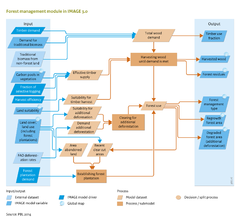Forest management/Data uncertainties limitations: Difference between revisions
Jump to navigation
Jump to search
Edelenbosco (talk | contribs) No edit summary |
Oostenrijr (talk | contribs) No edit summary |
||
| (2 intermediate revisions by 2 users not shown) | |||
| Line 16: | Line 16: | ||
===Limitations=== | ===Limitations=== | ||
<div class="version changev31"> | <div class="version changev31"> | ||
Timber demand in IMAGE 3.0 is the | Timber demand in IMAGE 3.0 is the total demand of sawlogs, pulpwood (both based on [[FAO]] for the historic period), and fuelwood (based on [[IEA]] and calculated by the [[TIMER model]]). The demand is fulfilled by harvesting wood from any type of forest without specifying the original source of demand. This can be relevant as different types of wood are used for timber, pulp and fuel. For fuelwood we assume that a certain fraction originate from informal sources, like gathering. For specific assessments it would be useful to include this detail in the allocation of forestry. | ||
The timber demand in a region is the sum of local/regional demands and timber claims by other regions. The trade assumptions are adopted from external models, limiting the application of the model for cases with regional timber scarcity | The timber demand in a region is the sum of local/regional demands and timber claims by other regions. The trade assumptions are adopted from external models, limiting the application of the model for cases with regional timber scarcity. | ||
The only driver of deforestation modelled in IMAGE 3.0 is the net expansion of | |||
agriculture per region. Many drivers of deforestation are not related to agricultural | |||
expansion, but there is no global assessment of these other drivers. Therefore, total | |||
deforestation rates in IMAGE are calibrated to FAO deforestation rates. Drivers and extent of deforestation are very uncertain and subject to debate, yet determine future deforestation and deforestation emissions in scenario simulations. | |||
</div> | </div> | ||
}} | }} | ||
Revision as of 14:46, 10 July 2017
Parts of Forest management/Data uncertainties limitations
| Component is implemented in: |
| Components: |
| Related IMAGE components |
| Projects/Applications |
| Key publications |
| References |
